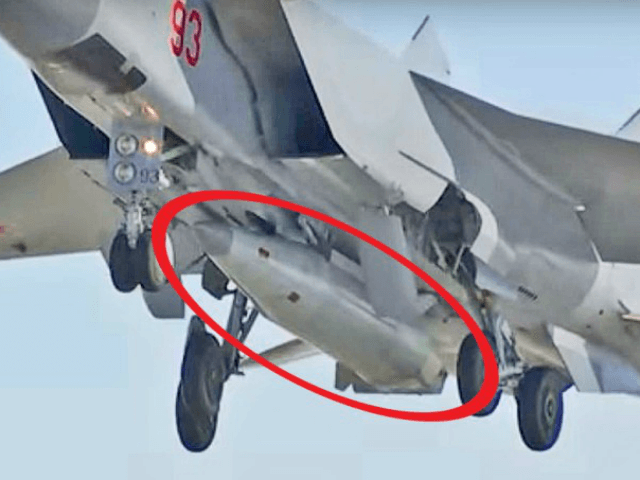The Russian Defense Ministry claimed on Thursday to have successfully tested the Kinzhal hypersonic cruise missile, the weapon described as “invincible” by Russian President Vladimir Putin.
According to the Defense Ministry, the drill “worked out the planning, preparation and joint use of Kinzhal air-launched missile systems with the Tu-22M3 missile-carrying bombers.” Launched from a Tu-22M Backfire bomber, the weapon would theoretically have a range in excess of 3,000 kilometers.
The Defense Ministry posted a video of the test, but the video shows a missile being launched by what appears to be a MiG-31 fighter jet while the Backfire bomber cruises nearby. The launch depicted in the video does not look much different from any other cruise missile firing.
U.S. intelligence believes was the 13th test of the Kinzhal, whose name means “dagger.” Many of the 12 previous test runs were clear failures or tested only parts of the weapon system. The latest launch may have represented the third fully successful test of the missile, but it would appear the Russians still have not figured out how to launch it from the long-range Backfire bombers yet. If those technical obstacles are resolved on schedule, Moscow expects the Kinzhal to be combat-ready by 2020.
The Kinzhal made its public debut at the May 2018 Victory Day parade in Moscow, when two MiG-31 fighters flew overhead carrying what appeared to be hypersonic missiles.
The Defense Ministry also posted video purporting to show the launch of a land-based hypersonic missile called the Avangard. The Avangard is said to be much closer to combat deployment, as it is currently entering production.
The ministry echoed Russian President Vladimir Putin’s claims that these hypersonic missiles are “invincible to all the existing and advanced air and missile defense system” fielded by the United States and its allies.
“Launching systems are also being designed, while technological processes to manufacture, assemble and test the missile are being improved. This range of work will make it possible to start designing a totally new sort of weapon – a strategic nuclear complex armed with a nuclear-powered missile,” the ministry added.
During Russia’s equivalent to the State of the Union address in March, shortly before the election he would prevail in, Putin claimed to have developed a cruise missile with “practically unlimited range and an unpredictable flight path, which can bypass lines of interception and is invincible in the face of all existing and future systems of both missile defense and air defense.”
This claim was accompanied by animations showing Russia’s new weapons striking targets in the United States and assurances that Putin was not bluffing about their deadly capabilities, including the ability to carry nuclear warheads.
While analysts debate whether Russia has actually achieved reliable hypersonic missile technology, there is little question that such weapons would indeed be nearly impossible to intercept, or even detect with a reasonable window of advance warning.
Hypersonic missiles can exceed five times the speed of sound, making them potentially twice as fast as high-performance fighter jets. They fly too high – or, in the model evidently pursued by the Russians, too low – to be intercepted until they have almost reached their targets, they move too fast to be hit by any other weapon, and they could provide as little as six minutes of warning between launch and impact. It might not even be possible to determine the precise target of a hypersonic missile until the weapon has almost arrived.
Both Russia and China have made no secret of aggressively pursuing hypersonic missile technology as a game-changer that would neutralize American advantages in missile detection and interception.

COMMENTS
Please let us know if you're having issues with commenting.